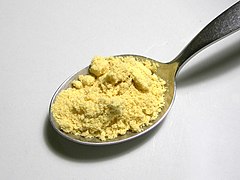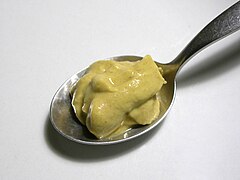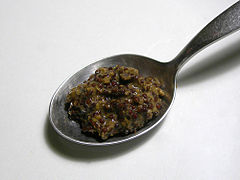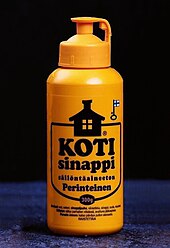Mustard
Mustard generally refers to packaged condiment with a pasty external appearance and sweet-sour flavor that is made from the seeds of various plants of the genus Sinapis, family of cruciferous plants, which also includes cabbages and turnips.
Likewise, it also refers to the small mustard seed, used as a spice and frequently used in some cuisines, such as: German, Indian or French, among others.
Etymology
In classical Spanish, mustard was called jenabe, which in turn comes from the Latin sinapis, and this from the Greek with the same name, from here comes the word sinapisms that are mustard poultices applied to the chest as a natural remedy for colds and other lung conditions.
The name, as it is known today, appears for the first time in France possibly around 1220 from a derivation of the Latin word mustum and the first recorded record of the name associated with the condiment is 'moutarde' and it is suspected that it comes from the Vulgar Latin mustum ardens ('burning must') because the Romans had the habit of adding, or diluting, mustard grains in the grape juice (must).. Almost at the same time it appears registered in Castilian with the name of mustard and in Italy with that of mostarda.
Mustard seeds are related from various religious approaches as the seeds of faith and abundance. This seed is named as something very small that multiplies and symbolizes abundance and the phenomenon of multiplicity.
History
Classical world
Archaeological excavations in the Indus Valley (Indian subcontinent) have revealed that mustard was grown there. That civilization existed until around 1850 B.C. C.
Mustard has been used in Africa and China for thousands of years. Mustard greens have been popularly consumed in China. Yellow mustard paste originated in China during the Zhou Dynasty (1046-256 BC), where mustard seeds were ground into a paste. It was often used in royal courts during the Zhou dynasty to help whet the appetite for later courses of a meal.
It is believed that the Romans developed the mustard mix we know today. They mixed unfermented grape juice -known as "mosto"- with mustard seeds -called sinapis- to form mustum ardens or " burning must". They used it as a gastronomic condiment; Pliny mentions it as an adjunct to spicy wines, and -since its leaves were also candied in vinegar- it was used to make moretum (spiced cheese). It was also used as a medicinal plant applied as a remedy against headaches or simply as a digestive. The Greeks used it as a condiment and Pythagoras recommended its consumption, since he believed that it improved memory and raised the spirits; it is also known that the botanist Teofrasto cultivated it in the gardens.
Middle Ages
This period can be considered as the first in which this spice had a boom. In fact, it is beginning to be used as a seasoning for meats (especially beef) and perhaps to hide the taste of spoiled meat. It is in the 13th century when it appears in almost all the dishes of European gastronomy, and its cultivation intensified; this can be seen in the cities of Cremona in Italy and Dijon in France; In the latter, production continues today, and it is considered one of the first in the world (a large part of the world production comes from this region of Burgundy and the other from Canada).
Modern Period
Already in modern times we find numerous different recipes by country, in Spain in the 17th century, for example, the cook of the kings of the House of Austria, Francisco Martínez Motiño, mentions a Spanish recipe production of mustard. Later in the 20th century it becomes famous for a simple odor resemblance to the yperite that mustard gas has (it has nothing else in common).
Today it is used as a dipping sauce on sausages (especially hot dogs) and is an important ingredient in hamburgers. It is also used in some sandwiches (mainly the American type that comes colored with turmeric, called prepared mustard). In several countries it also accompanies native fast foods such as arepa cabimera, tumbarranchos or patacón (in Venezuela) or sopaipillas (in Chile).
The French variety or Dijon type is usually used in gourmet-style dishes.
Properties
Mustard is a low-calorie sauce and is cholesterol-free since it does not contain any type of animal fat as an ingredient. Its seed has a high protein and mineral content. It also has antiseptic and digestive properties.
Content
Sweet white mustard (Brassica alba) grows wild in North Africa, the Middle East and Mediterranean Europe, spreading widely due to its long-term cultivation. Brown mustard (Brassica juncea), native to the foothills of the Himalayas, is grown commercially in the United Kingdom, Canada, and the United States. Black mustard (Brassica nigra) is cultivated in Argentina, Brazil, the United States and some European countries. Canada grows 90% of all mustard seed for international trade.
- types
Uses
It is known that there are some forty different species of mustard, of which only the so-called white mustard (Sinapis alba), the black mustard (Sinapis nigra) and wild mustard (Sinapis arvensis). It is mainly used in gastronomy as a seasoning for some dishes and in the preparation of some sauces, such as Cumberland (made with port) in Portuguese cuisine and Robert sauce, invented by Robert Vinot, in French gastronomy. In some Eastern European countries a sweet and sour mustard is used, made from two parts mustard to one part mayonnaise, seasoned with spices and sweetened with sugar.
Mustard is an ingredient that is present in many foods. Due to its ability to induce allergy processes, in accordance with the directives of the European Economic Community, its identification is mandatory in foods that contain it.
Contenido relacionado
Urbies cheese
Mitochondrial crest
Electroanalytical method






